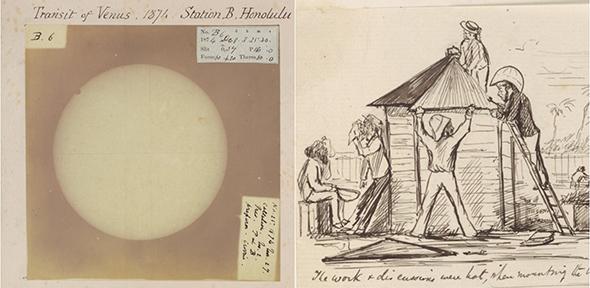
This month sees the launch of a new collection on the Cambridge Digital Library, drawing on Cambridge University Library archives and the private collection of Dr Charlotte Tupman to give a vivid account of the British expeditions of 1874 to observe the rare astronomical phenomenon of the transit of Venus.
Occurring in pairs over a century apart, transits of Venus had previously been observed in 1639, 1761 and 1769. The 18th- and 19th-century transits were marked by the efforts of many individuals and institutions across Europe and America to carry out observations. It was often necessary to make special expeditions, in order to reach locations from which the event could be seen and places widely separated on Earth. By making and timing near-simultaneous observations from precisely located observing stations across the globe, astronomers hoped to measure solar parallax. This was a means of establishing the distance between the Earth and the Sun (a distance now known as the Astronomical Unit) and, thus, knowledge of the real rather than relative scale of the Solar System. It was hoped and claimed that more accurate knowledge of the sizes and distances of the heavenly bodies would improve astronomical and navigational tables. These efforts of expeditionary astronomy drew on and fed into European interests in expanding trading opportunities and imperial and military influence.
The central individual around whom the material has been selected is Captain George Lyon Tupman of the Royal Marine Artillery (1838-1922): the chief organiser of the British effort both before and after the transit itself and chief astronomer for Station B. This collection brings together a selection of material from Tupman’s papers in the archive of the Royal Observatory, Greenwich, from the papers of the Astronomer Royal, George Airy, and from the private collection of Tupman’s descendants, including two albums of caricature drawings following “The Life and Adventures of Station B”, by one of the seven observers, Lieutenant E.J.W. Noble.
Noble’s caricatures give us the most unique and lively view of the expedition. We get to know the observers, their work, their frustrations and their entertainments. They, the instruments and some locations are drawn so as to be recognisable. The observers are well introduced at the top of this image, which below shows the complexities of sea travel, particularly when your baggage consists of tonnes of specialist equipment. The collection also includes photographs of instruments and observing huts, set up for practice in Greenwich and Washington.
The story of the transit, the project and the archive can be read in this fascinating Guardian article by Dr Rebekah Higgitt of the University of Kent.
